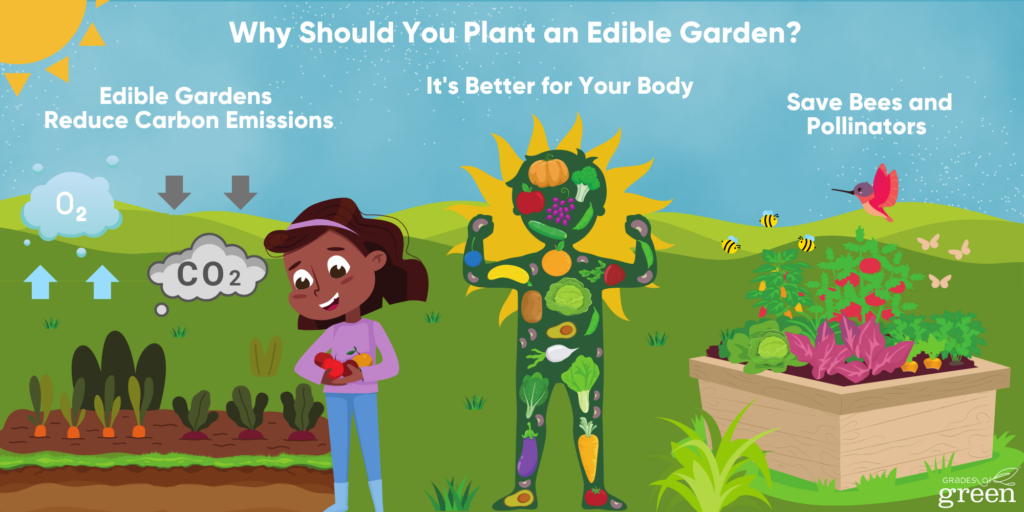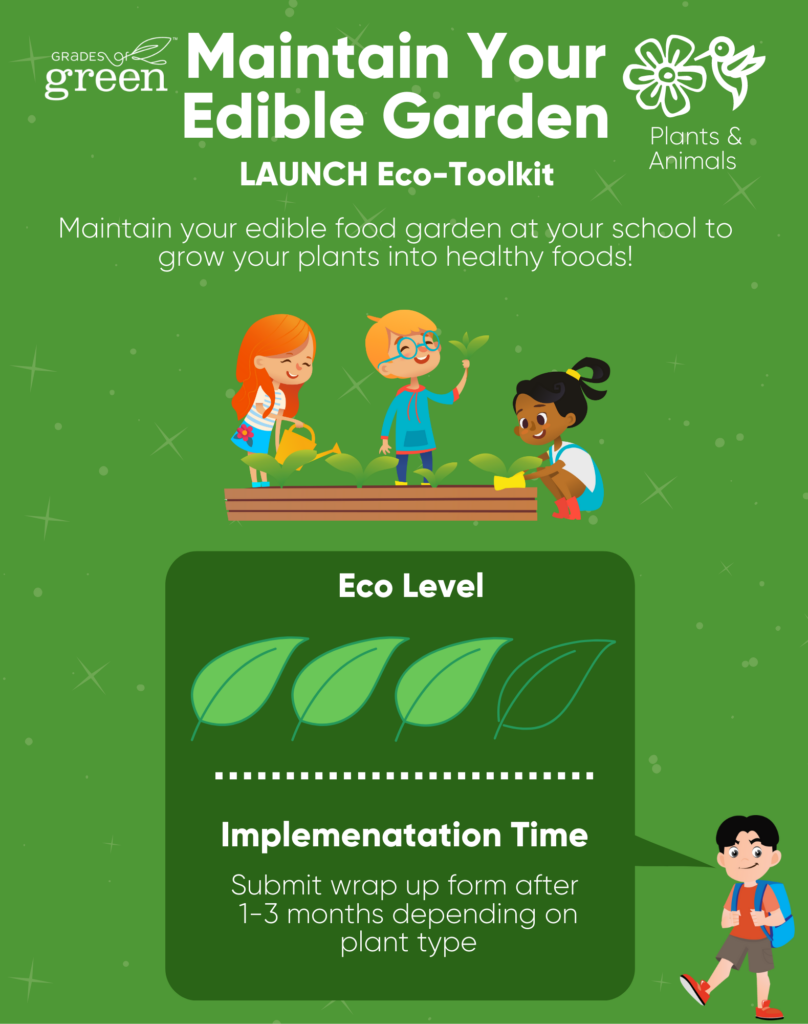You have your plan, now it’s time to PLANT!
In this second toolkit of the Edible Garden series, students will learn how to prepare their edible garden site and plant their seeds. They will also discover the positive impacts edible gardens have on the environment.
Grades of Green is proud to partner with Palos Verdes School Gardens and Kellogg Garden Products to bring you this toolkit.

Toolkit Details


NGSS
This toolkit address the following Science and Engineering Practices (SEPs) within the Performance Expectations of NGSS for Grades: K-2 and 3-5
- Asking Questions and Defining a Problem
- Planning and Carrying out Investigations
- Analyzing and Interpreting Data
- Using Mathematics and Computational Thinking
- Constructing Explanations and Designing Solutions
- Obtaining Evaluating, and Communicating Information
Learning Objectives
- Analysis
- Students will analyze their campus and determine best practices.
- Project Management
- Students will keep track of progress and care for a living plant.
- Students will practice leadership skills by delegating tasks to each other.
- Evaluation and Assessment
- Students will track and evaluate the impact of their project.
What is an Edible Garden & Why is it Important?
An edible garden is a garden where you can eat what you grow! Edible gardens that are organic do not use harmful pesticides (a substance used to remove insects/pests and can also hurt plants and animals). Organic gardens contain healthy soil that removes CO2 from our atmosphere and eliminates dangerous chemicals and toxins that can occur on commercial produce.
What You Will Accomplish
Students will prepare and plant their school edible garden by testing soil, deciding where seeds should go, and then planting them!
Educator Project Plan
Follow the steps below to set up a successful Edible Garden at your school! Need help? Contact us!
Track your metrics and submit your impact after implementing this toolkit. Your feedback helps keep our programs free for all across the globe.
Determine Participants
Use the Edible Garden Sign Up Sheet to have participants sign up. This step is for groups that did not use the PLAN toolkit or do not already have a team together. Skip this step if you already have a team together.
- A Student Group such as (a club, before/after school program, non-school organization)
- A whole class
- The whole school
- An adult garden committee to support the students: Custodial staff, teachers, administrators, parent volunteers
- Working in a small student group? Determine roles for each student
- A Whole class? Divide the class into groups to lead different tasks
- The Whole school? Have a core group of student leaders to implement tasks and educate the rest of the students during an assembly or walking assemblies
Why Should You Plant an Edible Garden
The resources provided below can be shown as a slideshow or printed out as individual worksheets for students to review.

Edible Gardens Reduce Carbon Emissions
Growing food in a school, home, or community garden reduces carbon emissions. Transporting fruits and vegetables from a farm to our markets means trucks, planes, and ships are producing carbon emissions, which are harmful to our planet. In fact, food transportation creates one fifth of the total emissions of the food industry. Also, fresh-picked food from a garden doesn’t need plastic packaging! [1]
It’s Better for Your Body
Garden-grown food is better for our health. Because we pick our fruits and vegetables later on in the growth cycle, there’s more nutrients in garden produce than large-scale agriculture produce. Plus, you save money! [2]
Save Bees & Other Pollinators
Growing your own food without pesticides, including herbicides, supports local ecosystems. According to The Bee Conservancy, harmful pesticides are a leading cause of pollinator declines. [3] By growing fruits and vegetables, you can provide a safe haven for pollinators (who are really important for the earth’s ecosystems!)
Why Food is a Social Justice Issue
Food Deserts (or areas where it’s hard to get fresh food and produce) and food swamps (areas that lack fresh food/produce but offer a lot of unhealthy and fast foods) are environmental justice issues. People who live in communities with limited access to fresh produce and whole foods, often consume more processed/fast food than fresh food. These types of foods take more energy to produce and transport and release carbon emissions unlike their nutritious counterparts – fresh fruits and vegetables. Access to fresh fruits and vegetables to all can not only improve health but it is also better for our planet. [4]
Watch these Short Videos to Learn More on Planting a Garden
Think About It!
Pre-Activity Questions
- What are the benefits of preparing your soil?
- What are some of the environmental benefits that can be addressed in preparations and planting?
- What are some organizations we can connect with to get supplies and seeds?
Take Action: LAUNCH the Planting of Your Edible Garden
Lead students through the Plant an Edible Garden activity with guided instructions. Check out “Pro Tips” for additional help.
1. Assign Roles
Using the Edible Garden Roles Worksheet, assign or allow students to pick roles in order to plan a garden. Some roles can include:
- Vegetable Planter
- Fruit Planter
- Seed Organizer
Feel free to add more roles and get creative with the names to make it more fun!
2. Get Your Soil Ready
Now that you have a plan for your garden, it’s time to prepare the soil for your seeds.
- Learn the Difference between garden soil and raised bed soil!
- If you are planting in-ground, make sure to test your soil. Follow Kellogg Garden’s How to Tell if Soil is Good with 8 Simple Tests. Use this guide to check the texture of your soil.
- Determine what type of soil you need
- Use this Soil Calculator to figure out how much soil you will need
3. Grab Your Grid
Use the Edible Garden Grid you made in the PLAN Your Edible Garden Toolkit, to “draw” lines in your garden beds with your hands or a shovel. If you would like to make your grid more visible, use garden twine or string.
4. Starting Your Seeds
Now that your soil is prepared and your grid is created, it’s time to start your seeds! Here are some steps to get your started:
- If you are starting seeds prior to planting in your garden, Check out this video for some helpful tips.
- Make sure to reuse small plant containers, cardboard egg cartons, or milk cartons to start your seeds!
- When the seedlings are large enough, transfer them to your garden
- If you are planting your seeds directly in your garden:
- Using two fingers, make holes in the dirt for your seeds
- Drop a few seeds in each hole and cover them with soil
- Water the soil
To prevent harvesting all of your plants at once, plant crops every week so you can harvest over multiple weeks. This is called succession planting.
5. Fertilize Your Garden
Organic fertilizers are made of plants or animal products and are recommended because they are:
- Hard to over apply
- Help nourish soil microbes
- Improve soil structure
- Safer for people and the environment
- Compost
- Liquid seaweed
- Fish emulsion
- Bone meal
- Blood meal
- Alfalfa meal
- Cottonseed meal
- Composted manure
Synthetic fertilizers can harm the microorganisms that sequester (or absorb) carbon. Also, applications of synthetic nitrogen fertilizer can cause emissions of nitrous oxide, a greenhouse gas 300 times more potent than carbon dioxide.
- The nutrients in organic compost are released over time through microorganisms so they feed the plants for a long time.
- Plants take up nutrients through their roots so remember to start with good soil
- The soil test you did in the last toolkit can tell you if your pH is balanced for the chosen plants. This means the plant will be able to use the nutrients.
- Many plants will need additional fertilizing through the growing season.
- Observe the plants looking for growth and health to see if it needs additional fertilizer.
Three major nutrients that plants need are:
- Nitrogen for growth and keeping the leaves green.
- Phosphorus for helping roots grow strong, flower and fruit setting, and disease resistance.
- Potassium for overall health, fruit ripening, and disease resistance.
Edible garden plants like to bed fed every 2-4 weeks with a liquid or granular organic fertilizer. Make sure to incorporate this when planning your maintenance schedule.
Reflection Questions
How’d It Go?
- What was the most challenging part in the planting process?
- Which next step are you most excited about?
- Why is planting an edible garden beneficial to the Climate Crisis?
Report Students’ Impact
Congratulations!! You’ve Planted an Edible Garden! Don’t let all that hard work go unnoticed. Submit your results by clicking the green button below.
By reporting your impact, Grades of Green can:
- CELEBRATE and elevate your students’ hard work and success.
- Offer our programs FREE for all students across the globe.
- AWARD stipends and certificates to hard-working educators and students.
Please take a few minutes to submit your results. Thank you!
Next Steps
Congrats on Planting Your Edible Garden! Get started on Toolkit #3: Maintain Your Edible Garden!

Provided Resources
- Edible Garden Series Google Resources
- Edible Garden Series Sign Up Sheet
- Edible Garden Series Roles Worksheet
- Edible Garden Series Grid Plan
- Plant Your Garden Slides
- Plant Your Edible Garden Wrap Up Form
Did you enjoy this toolkit? Get ready to maintain your edible garden!